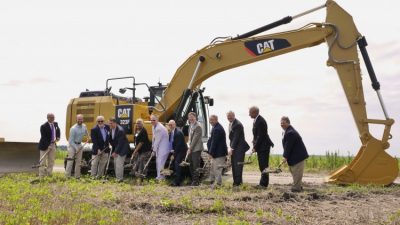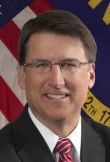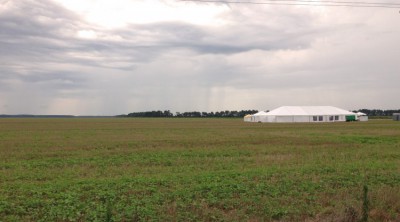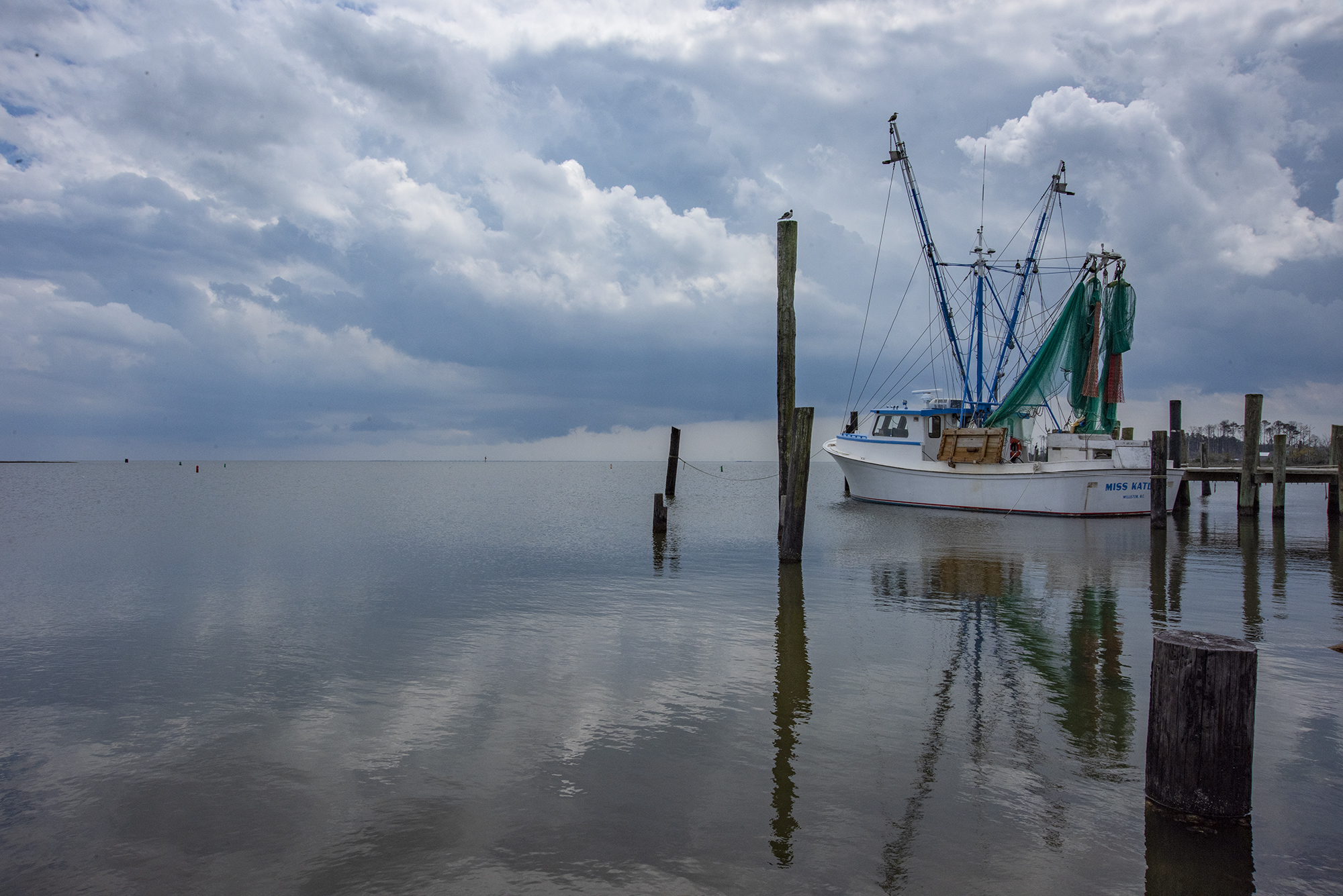ELIZABETH CITY — In a remarkable convergence of happenstance and politics, this conservative Southern river town has become a prime example of the innovative energy technology that the Obama administration is now aggressively pursuing.

Economic Development Commission
Three weeks before Obama’s announcement on Monday about stricter carbon standards for power plants, the Amazon Wind Farm U.S. East, the first commercial-scale wind farm in the state, broke ground on 22,000 acres of farmland near Elizabeth City and Hertford, in Pasquotank and Perquimans counties, respectively.
Supporter Spotlight
“I think that this is a just another piece of evidence that shows that clean energy policy is working for North Carolina,” said Maggie Clark, government affairs associate for the N.C. Sustainable Energy Association. “It really does go back to being an economic development success story.”
Built and operated by Iberdrola Renewables at Desert Wind, the $400 million project’s first phase will include construction of 104 turbines that generate up to 208 megawatts of energy. The power will be sold to online retail and technology behemoth Amazon as renewable energy credits that will offset electricity used at its cloud data centers in Ohio and Virginia.
“That was the cherry on top of the sundae,” said Wayne Harris, director of the Elizabeth City and Pasquotank County Economic Development Commission, referring to the Amazon deal of which he learned the night before the groundbreaking on July 14.

Overall, he said, the Iberdrola announcement has been a “pinch me, I’m dreaming” moment. Not only will there will be 250 jobs created to build the wind farm, which is expected to begin generating power by December 2016, Harris said, it will also require 10 permanent positions to operate it. The company will also get a 94 percent tax rebate in the first year and a projected 25 percent discount after 15 years.
But there are significant financial dividends for the two counties: 62 landowners will be paid about $6,000 a year for each turbine on their land, with increases in future years. Iberdrola will also pay $5,000 per tower – 54 in Perquimans, 50 in Pasquotank – in taxes each year, with 1½-percent annual inflation rate increases.
Supporter Spotlight
“That’s $250,000 a year to Pasquotank, which makes Iberdrola comfortably the largest taxpayer in Pasquotank,” Harris said, adding that Perquimans will enjoy a similar windfall.
In North Carolina’s rankings of the economic well-being of its 100 counties, Pasquotank and Perquimans have each consistently been rated a Tier 1 county, the bottom rung, based on population and poverty. In 2015, of all N.C. counties Pasquotank ranked No. 26 and Perquimans No. 64 in economic distress, with the lower number being worse.
Support for Clean Energy
Although the Iberdrola-Amazon announcement preceded release of Obama’s carbon-reduction mandate, the wind farm coincides with the president’s goal to encourage use of clean energy sources. The new Environmental Protection Agency rule will require power producers by 2030 to reduce carbon emissions 32 percent below the levels they were a decade ago.
Gov. Pat McCrory has been supportive of renewable energy development in the state, and he spoke at the event last month.

“The Amazon Wind Farm is a significant step toward diversifying North Carolina’s energy resources,” McCrory said. “Bringing onshore wind production to North Carolina is part of my ‘all of the above’ energy strategy. By diversifying our energy resources, we can provide affordable reliable, and secure sources of energy that are environmentally clean and safe.”
While Iberdrola is now a done deal, some state legislators have tried to pass a bill that would freeze renewable energy and energy efficiency portfolio standards that many believe have encouraged development of solar and wind projects in the state. State law currently requires utilities to produce at least 12.5 percent of their electrical power with renewable energies by 2021.
“Right now, as a state, we’re at 6 percent and the utilities are on the path to compliance,” said Clark. “The bill (H-332) would essentially freeze it at 6 percent.”
In a controversial move in May, Sen. Bob Rucho, R-Mecklenburg, chairman of the Senate Finance Committee, deemed that the bill had passed in committee, despite a voice vote that appears to show that it failed. But Rucho refused to allow a show of hands.

No further action has yet been taken on the bill, Clark said. But Clark said that the state is sending mixed signals that could spook continued investments in renewable power sources.
In recent years, North Carolina has become one of the leaders nationwide in development of utility-scale solar energy, and there is interest in numerous wind projects.
“It’s quite a bit of money coming into the state,” she said. “We look to the legislature to attract economic development into our state and for that, we need policy certainty.”
In addition to Amazon, she said, Apple, Google and Facebook each have interests in renewable energy in North Carolina. “I think that this is really telling that large multinational companies are choosing clean energy,” Clark said.
In a letter sent to the General Assembly in June, 11 business leaders in the state asked that the Renewable Energy Investment Tax Credit, which is scheduled to expire on Dec. 31, be continued.
“Access to renewable energy technologies can be difficult for companies like ours in highly regulated electricity markets such as North Carolina,” the letter said. “Nonetheless, these technologies allow our company to meet our financial and sustainability goals and are important to our success in North Carolina . . . The (tax credit) makes these technologies accessible, improving North Carolina’s business climate.”
Clearing the Hurdles
Paul Copleman, spokesman for Iberdrola, said equipment is expected on the ground in a couple of weeks to improve existing roads and develop access roads for tower locations. Turbine delivery will not happen until next year.

Economic Development Commission
Copleman said that the company is hopeful the second phase of construction, installation of an additional 46 turbines, will be scheduled in a few years, after the company and the Defense Department complete a study of the potential effects of wind-power turbines on Navy radar. Copleman said that the company believes that the military’s concerns have been addressed in the first phase design and that there will be no effect on radar.
“That will be an important understanding that we will need to get our arms around before moving to Phase II,” he said.
Copleman said that Iberdrola has secured all necessary state and federal permits for the project, and has worked with “an alphabet soup of agencies and entities” to mitigate effects on birds, bats and the environment surrounding the project.
“That’s one of the reasons it took five years to get to this point,” he said.
Iberdrola was stalled for a while in trying to find the right buyer for the large amount of energy – about 670,000 megawatt hours – the farm is expected to produce annually. That’s enough to power 61,000 homes for one year, according to a press release from Amazon Web Services.
Copleman said the company persisted because it viewed the undeveloped location as attractive and viable.
“It’s the intersection of a consistent, steady wind with access to transmission lines, a supportive community and participating landowners,” he said. “We’re excited to have reached this point and we’re looking forward to a longstanding relationship. We’re looking at this as a very long-term investment.”
The towers, which with a blade pointing straight up will stand about 500 feet tall, will be visible from the Tanglewood Pavilions off Halstead Boulevard and the U.S. 17 bypass, Harris said. The project area is about 15 miles from the Albemarle Sound and 30 miles from the Atlantic Ocean.
But with “extremely generous setbacks” in the vast farmland, Harris said noise is very unlikely to be an issue with the turbines.
Harris said Elizabeth City is happy to host the first commercial wind farm in the state. He welcomed the attention the groundbreaking event received from more than 120 media outlets.
“The only thing that came close was in 2007, when Ron Paul rented a blimp,” he said.







